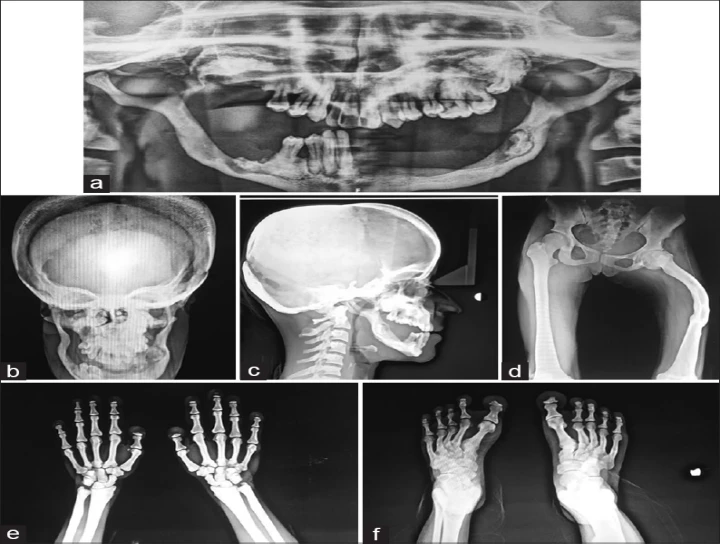
**Pycnodysostosis** is a rare genetic disorder characterized by a variety of skeletal abnormalities, including osteosclerosis (increased bone density), short stature, and distinctive facial features. When pycnodysostosis is associated with **osteomyelitis**, it presents a unique challenge in diagnosis and management. Let’s delve into the details:
### Pycnodysostosis Overview
- **Etiology:** Pycnodysostosis is caused by mutations in the **CTSK gene** (cathepsin K gene), which is crucial for bone resorption. The condition is inherited in an autosomal recessive pattern.
- **Key Features:**
- **Skeletal Abnormalities:** Dense, brittle bones that are prone to fractures.
- **Facial Features:** Characteristic facial features include a prominent forehead, small face, and a rounded face.
- **Short Stature:** Individuals with pycnodysostosis typically have a shorter stature compared to the general population.
- **Dental Issues:** Dental abnormalities are common, including delayed eruption of teeth and malocclusion.
### Osteomyelitis Overview
- **Definition:** Osteomyelitis is an infection of the bone, usually caused by bacteria, which can lead to inflammation and bone destruction.
- **Common Causes:** It can result from hematogenous spread (infection from the bloodstream), contiguous spread from adjacent tissues, or direct inoculation from trauma or surgery.
### Pycnodysostosis and Osteomyelitis: Unraveling the Connection
**The Intersection:**
1. **Increased Bone Density:**
- The increased bone density in pycnodysostosis might influence the susceptibility to infections such as osteomyelitis. The dense bone may impair effective blood flow, potentially increasing the risk of infection or complicating the resolution of infections.
2. **Dental Issues:**
- Patients with pycnodysostosis often have dental issues such as delayed tooth eruption and malocclusion. These dental problems can predispose them to oral infections, which might spread to the surrounding bone, leading to osteomyelitis.
3. **Bone Fragility:**
- Despite the increased density, the bones are still brittle and prone to fractures, which can lead to disruptions in the normal bone structure and potentially predispose to infections.
4. **Impaired Wound Healing:**
- The bone abnormalities and potentially compromised blood supply in pycnodysostosis might impair wound healing, making infections like osteomyelitis more difficult to manage.
### Clinical Manifestations and Diagnosis
1. **Symptoms:**
- **Pain and Swelling:** Localized pain, swelling, and redness at the infection site.
- **Fever:** Systemic symptoms such as fever may be present.
- **Functional Impairment:** Limited movement or function of the affected area.
2. **Imaging Studies:**
- **X-rays:** May show changes in bone density and the presence of osteomyelitis.
- **CT and MRI:** These can provide detailed images of the bone and soft tissue involvement, helping to diagnose osteomyelitis and assess the extent of the infection.
3. **Laboratory Tests:**
- **Blood Tests:** Elevated inflammatory markers (e.g., ESR, CRP) can indicate infection.
- **Bone Biopsy:** May be needed to confirm the diagnosis of osteomyelitis and identify the causative organism.
### Management and Treatment
1. **Antibiotic Therapy:**
- **Empirical Treatment:** Initial broad-spectrum antibiotics may be administered while awaiting culture results.
- **Targeted Therapy:** Based on culture and sensitivity results, targeted antibiotics are used to treat the specific pathogen.
2. **Surgical Intervention:**
- **Debridement:** Surgical removal of necrotic and infected tissue may be necessary to control the infection and promote healing.
- **Bone Grafting:** In cases of significant bone loss, bone grafting may be required to support bone regeneration.
3. **Orthopedic Care:**
- **Fracture Management:** Management of fractures and bone deformities should be tailored to the patient’s needs.
- **Orthopedic Follow-Up:** Regular monitoring and follow-up with an orthopedic specialist to address any ongoing issues related to bone density and integrity.
4. **Supportive Care:**
- **Pain Management:** Adequate pain control is essential for patient comfort and recovery.
- **Nutritional Support:** Ensuring proper nutrition can aid in the overall healing process.
### Conclusion
Pycnodysostosis with osteomyelitis presents a complex clinical scenario due to the interplay between increased bone density and susceptibility to infection. The management of these patients requires a multidisciplinary approach involving orthopedic surgeons, infectious disease specialists, and other healthcare providers. Early diagnosis and prompt treatment are crucial to improving outcomes and addressing both the pycnodysostosis and the associated osteomyelitis effectively.


No Any Replies to “Unraveling the Puzzle: Pycnodysostosis with Osteomyelitis”
Leave a Reply